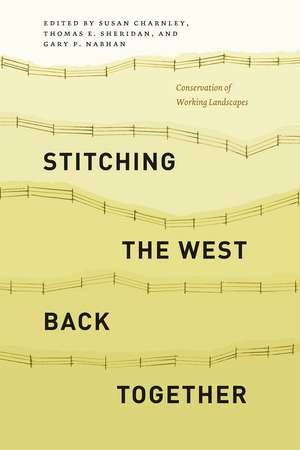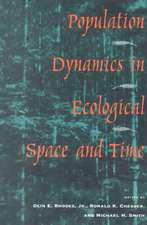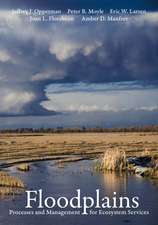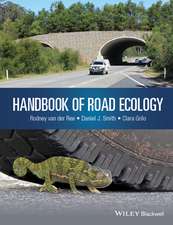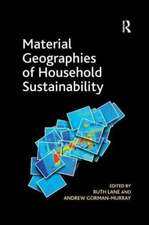Stitching the West Back Together: Conservation of Working Landscapes: Summits: Environmental Science, Law, and Policy
Editat de Susan Charnley, Thomas E. Sheridan, Gary P. Nabhanen Limba Engleză Paperback – 18 sep 2014
News headlines would often have us believe that conservationists are inevitably locked in conflict with the people who live and work on the lands they seek to protect. Not so. Across the western expanses of the United States, conservationists, ranchers, and forest workers are bucking preconceptions to establish common ground. As they join together to protect the wide open spaces, diverse habitats, and working landscapes upon which people, plants, and animals depend, a new vision of management is emerging in which the conservation of biodiversity, ecosystem integrity, and sustainable resource use are seen not as antithetical, but as compatible, even symbiotic goals.
Featuring contributions from an impressive array of scientists, conservationists, scholars, ranchers, and foresters, Stitching the West Back Together explores that expanded, inclusive vision of environmentalism as it delves into the history and evolution of Western land use policy and of the working landscapes themselves. Chapters include detailed case studies of efforts to promote both environmental and economic sustainability, with lessons learned; descriptions of emerging institutional frameworks for conserving Western working landscapes; and implications for best practices and policies crucial to the future of the West’s working forests and rangelands. As economic and demographic forces threaten these lands with fragmentation and destruction, this book encourages a hopeful balance between production and conservation on the large, interconnected landscapes required for maintaining cultural and biological diversity over the longterm.
Featuring contributions from an impressive array of scientists, conservationists, scholars, ranchers, and foresters, Stitching the West Back Together explores that expanded, inclusive vision of environmentalism as it delves into the history and evolution of Western land use policy and of the working landscapes themselves. Chapters include detailed case studies of efforts to promote both environmental and economic sustainability, with lessons learned; descriptions of emerging institutional frameworks for conserving Western working landscapes; and implications for best practices and policies crucial to the future of the West’s working forests and rangelands. As economic and demographic forces threaten these lands with fragmentation and destruction, this book encourages a hopeful balance between production and conservation on the large, interconnected landscapes required for maintaining cultural and biological diversity over the longterm.
Preț: 310.21 lei
Nou
Puncte Express: 465
Preț estimativ în valută:
59.38€ • 64.52$ • 49.91£
59.38€ • 64.52$ • 49.91£
Carte tipărită la comandă
Livrare economică 21 aprilie-05 mai
Preluare comenzi: 021 569.72.76
Specificații
ISBN-13: 9780226165714
ISBN-10: 022616571X
Pagini: 352
Ilustrații: 26 halftones, 5 tables
Dimensiuni: 152 x 229 x 28 mm
Greutate: 0.7 kg
Editura: University of Chicago Press
Colecția University of Chicago Press
Seria Summits: Environmental Science, Law, and Policy
ISBN-10: 022616571X
Pagini: 352
Ilustrații: 26 halftones, 5 tables
Dimensiuni: 152 x 229 x 28 mm
Greutate: 0.7 kg
Editura: University of Chicago Press
Colecția University of Chicago Press
Seria Summits: Environmental Science, Law, and Policy
Notă biografică
Susan Charnley is a research social scientist at the USDA Forest Service’s Pacific Northwest Research Station. She has published numerous articles relating to rural communities and forest management in the West. Thomas E. Sheridan is professor of anthropology at the University of Arizona and a research anthropologist at the university’s Southwest Center. He is the author of several books, including Landscapes of Fraud: Mission Tumacácori, the Baca Float, and the Betrayal of the O’odham. Gary P. Nabhan is a research scientist at the University of Arizona’s Southwest Center. He is the author or editor of twenty-four books, including, most recently, Desert Terroir: Exploring the Unique Flavors and Sundry Places of the Borderlands.
Cuprins
Foreword Charles F. Wilkinson
Introduction Susan Charnley, Thomas E. Sheridan, and Gary P. Nabhan
Part 1 The Importance of ConservIng Western WorkIng Landscapes
Chapter 1 A Brief History of People and Policy in the West
Thomas E. Sheridan and Nathan F. Sayre
Chapter 2 Status and Trends of Western Working Landscapes
Susan Charnley, Thomas E. Sheridan, and Nathan F. Sayre
Chapter 3 The Biodiversity That Protected Areas Can’t Capture: How Private Ranch, Forest, and Tribal Lands Sustain Biodiversity
Gary P. Nabhan, Richard L. Knight, and Susan Charnley
Part 2 CollaboratIve Conservation
Chapter 4 Beyond “Stakeholders” and the Zero- Sum Game: Toward Community- Based Collaborative Conservation in the American West
Thomas E. Sheridan, Nathan F. Sayre, and David Seibert
Spotlight 4.1 Historic Precedents to Collaborative Conservation in Working Landscapes: The Coon Valley “Cooperative Conservation” Initiative, 1934
Curt Meine and Gary P. Nabhan
Chapter 5 The Quivira Experience: Reflections from a “Do” Tank Courtney White
Spotlight 5.1 Grass- Fed and Grass- Finished Livestock Production: Helping to Keep Working Landscapes Intact
Gary P. Nabhan, Carrie Balkcom, and Amanda D. Webb
Chapter 6 Place- Based Conservation Finds Its Voice: A Case Study of the Rural Voices for Conservation Coalition
Maia Enzer and Martin Goebel
Part 3 Case Studies of WorkIng Forests
Chapter 7 Swan Story
Melanie Parker
Spotlight 7.1 Arcata Community Forest
Mark Andre
Chapter 8 Taking a Different Approach: Forestland Management in the Redwood Region
Mike Jani
Spotlight 8.1 The Conservation Fund’s Garcia River Forest, California
Chris Kelly
Chapter 9 Stewardship Contracting in the Siuslaw National Forest
Shiloh Sundstrom and Johnny Sundstrom
Spotlight 9.1 Stewardship Agreements: The Weaverville Community Forest, California
Pat Frost
Part 4 Case Studies of WorkIng Ranches
Chapter 10 Lava Lake Land & Livestock: The Role of Private Landowners in Landscape- Scale Conservation
Michael S. Stevens
Spotlight 10.1 Country Natural Beef
Susan Charnley and Sophia Polasky
Chapter 11 Conservation and Development at Sun Ranch: The Search for Balance in the U.S. West
Roger Lang, William H. Durham, and Josh Spitzer
Spotlight 11.1 The Madison Valley Ranchlands Group
Thomas E. Sheridan
Chapter 12 Integrating Diversified Strategies on a Single Ranch: From Renewable Energy and Multiple Breeds to Conservation Easements
Dennis Moroney
Spotlight 12.1 Private Land Conservation Trends in the Western United States
Jon Christensen, Jenny Rempel, and Judee Burr
Part 5 EmergIng Approaches to ConservIng WorkIng Landscapes
Chapter 13 The Sonoran Desert Conservation Plan and Ranch Conservation in Pima County, Arizona
Thomas E. Sheridan
Spotlight 13.1 Ranching and the “Death Tax”: A Matter of Conservation as Well as Equity
Thomas E. Sheridan, Andrew Reeves, and Susan Charnley
Chapter 14 Payments for Ecosystem Services: Keeping Working Landscapes Productive and Functioning
Gary P. Nabhan, Laura López- Hoffman, Hannah Gosnell, Josh Goldstein, Richard Knight, Carrie Presnall, Lauren Gwin, Dawn Thilmany, and Susan Charnley
Spotlight 14.1 The Conservation Reserve Program
Steven E. Kraft
Conclusions and Policy Implications
Thomas E. Sheridan, Gary P. Nabhan, and Susan Charnley
Acknowledgments
Contributor Biographies
Summits Board of Advisers
Index
Introduction Susan Charnley, Thomas E. Sheridan, and Gary P. Nabhan
Part 1 The Importance of ConservIng Western WorkIng Landscapes
Chapter 1 A Brief History of People and Policy in the West
Thomas E. Sheridan and Nathan F. Sayre
Chapter 2 Status and Trends of Western Working Landscapes
Susan Charnley, Thomas E. Sheridan, and Nathan F. Sayre
Chapter 3 The Biodiversity That Protected Areas Can’t Capture: How Private Ranch, Forest, and Tribal Lands Sustain Biodiversity
Gary P. Nabhan, Richard L. Knight, and Susan Charnley
Part 2 CollaboratIve Conservation
Chapter 4 Beyond “Stakeholders” and the Zero- Sum Game: Toward Community- Based Collaborative Conservation in the American West
Thomas E. Sheridan, Nathan F. Sayre, and David Seibert
Spotlight 4.1 Historic Precedents to Collaborative Conservation in Working Landscapes: The Coon Valley “Cooperative Conservation” Initiative, 1934
Curt Meine and Gary P. Nabhan
Chapter 5 The Quivira Experience: Reflections from a “Do” Tank Courtney White
Spotlight 5.1 Grass- Fed and Grass- Finished Livestock Production: Helping to Keep Working Landscapes Intact
Gary P. Nabhan, Carrie Balkcom, and Amanda D. Webb
Chapter 6 Place- Based Conservation Finds Its Voice: A Case Study of the Rural Voices for Conservation Coalition
Maia Enzer and Martin Goebel
Part 3 Case Studies of WorkIng Forests
Chapter 7 Swan Story
Melanie Parker
Spotlight 7.1 Arcata Community Forest
Mark Andre
Chapter 8 Taking a Different Approach: Forestland Management in the Redwood Region
Mike Jani
Spotlight 8.1 The Conservation Fund’s Garcia River Forest, California
Chris Kelly
Chapter 9 Stewardship Contracting in the Siuslaw National Forest
Shiloh Sundstrom and Johnny Sundstrom
Spotlight 9.1 Stewardship Agreements: The Weaverville Community Forest, California
Pat Frost
Part 4 Case Studies of WorkIng Ranches
Chapter 10 Lava Lake Land & Livestock: The Role of Private Landowners in Landscape- Scale Conservation
Michael S. Stevens
Spotlight 10.1 Country Natural Beef
Susan Charnley and Sophia Polasky
Chapter 11 Conservation and Development at Sun Ranch: The Search for Balance in the U.S. West
Roger Lang, William H. Durham, and Josh Spitzer
Spotlight 11.1 The Madison Valley Ranchlands Group
Thomas E. Sheridan
Chapter 12 Integrating Diversified Strategies on a Single Ranch: From Renewable Energy and Multiple Breeds to Conservation Easements
Dennis Moroney
Spotlight 12.1 Private Land Conservation Trends in the Western United States
Jon Christensen, Jenny Rempel, and Judee Burr
Part 5 EmergIng Approaches to ConservIng WorkIng Landscapes
Chapter 13 The Sonoran Desert Conservation Plan and Ranch Conservation in Pima County, Arizona
Thomas E. Sheridan
Spotlight 13.1 Ranching and the “Death Tax”: A Matter of Conservation as Well as Equity
Thomas E. Sheridan, Andrew Reeves, and Susan Charnley
Chapter 14 Payments for Ecosystem Services: Keeping Working Landscapes Productive and Functioning
Gary P. Nabhan, Laura López- Hoffman, Hannah Gosnell, Josh Goldstein, Richard Knight, Carrie Presnall, Lauren Gwin, Dawn Thilmany, and Susan Charnley
Spotlight 14.1 The Conservation Reserve Program
Steven E. Kraft
Conclusions and Policy Implications
Thomas E. Sheridan, Gary P. Nabhan, and Susan Charnley
Acknowledgments
Contributor Biographies
Summits Board of Advisers
Index
Recenzii
“Stitching the West Back Together makes a powerful argument for the importance of private lands in biodiversity conservation and the interdependence of public and private lands in the sustainability of working landscapes, which in turn is inextricably linked with the conservation of biodiversity in the West. What is unique about this book is that it addresses the problem and the potential solutions together and in a holistic way, giving an honest and balanced overview. An exciting contribution to the collaborative conservation literature, this book provides hope, tools, and recommendations that will help advance the use of collaborative conservation in the western United States.”
“Substantial, useful, and accessible, this book gives novel voice to people who have been at the heart of collaborative initiatives, allowing them to tell their stories in a powerful way. It is also one of the rare books that brings together work in forests and rangelands. Compelling.”
“Stitching the West Back Together is an excellent read and a highly important contribution. This book fills a glaring gap, helping us to understand the transformation of the West and the way we foster that transformation. Chapters from both non-academic practitioners as well as academics involved in on-the-ground conservation effectively connect theory and practice, and make this book exceptional. Stitching the West Back Together will be extremely useful for university faculty and students, rural communities and civic groups, public land managers, and private businesses in forestry, farming, and ranching. Not only does it chart the contours of a changing West, it provides the depth and detail needed to inspire real change and action.”
“In the magnificent, hard-pressed lands west of the Mississippi, the war to define good stewardship intensifies every year. Stitching the West Back Together offers, instead, a peace process: practical, community-based, and frequently inspiring. Can healthy terrain yield healthy profit? Almost certainly, according to these well-chosen case studies, which argue for a new public policy of interdependence and cooperation, fueled by redoubled respect for the history and ecology of this most difficult, subtle, and underappreciated of US regions.”
“The book urges conservationists, government employees, tribal officials, and private landowners to meet at the ‘Radical Center,’ where goals are ambitious and, most importantly, shared: building a West that is ecologically, aesthetically and culturally healthy. . . . Each chapter moves deftly from data to ‘how-to,’ and offers a bullet-point list of lessons. Readers facing specific challenges can find stories that speak to their needs, but people with more general interests will also find the book as a whole accessible and even inspiring. Both will come away with new ideas for entrepreneurial approaches to conservation. With sections by an impressive range of scholars and practitioners, Stitching embodies its own lesson—that success is achieved by working with a diversity of approaches.”
“This work reviews recent developments regarding attempts to conserve working landscapes in the western United States. Individual chapters (fourteen total) in the five parts . . . are written by authors ranging from graduate students and academics to practitioners and activists. . . . The argument for collaborative conservation, including working landscapes to prevent urbanization and sprawl, sounds like a win-win situation for everyone, except for developers. . . . An intriguing start for those wanting to explore issues related to options for collaborative conservation and land management in the checkerboard landscapes of the West in further detail. . . . Recommended.”
“An excellent resource. . . . While collaborative conservation is not a panacea, Stitching the West Back Together offers additional evidence that it may offer the best hope to shape vibrant economies, livable communities, and healthy landscapes. The case studies and historical narratives presented in this book should inspire, inform, and invigorate similar efforts throughout the American West. The chapters are concise, well written, and appropriately illustrated with maps and other images. The editors are to be commended for this contribution to the theory and practice of collaborative conservation and large landscape conservation.”
“Stitching the West Back Together provides an overview of the amazing variety of social partnerships, coalitions or organizations (termed ‘community-based collaborative conservation groups’ [CBCCs] in the book), and conservation approaches that aim to save working landscapes of the American West. . . . Despite the breadth of the topic and the variety of local CBCCs and their conservation activities, the book is easy to follow, thanks to an organization that really works.”
